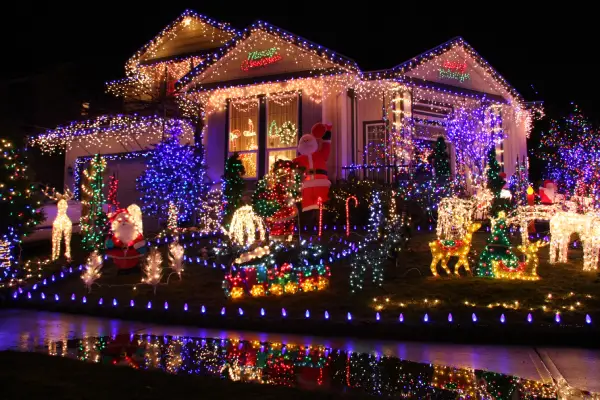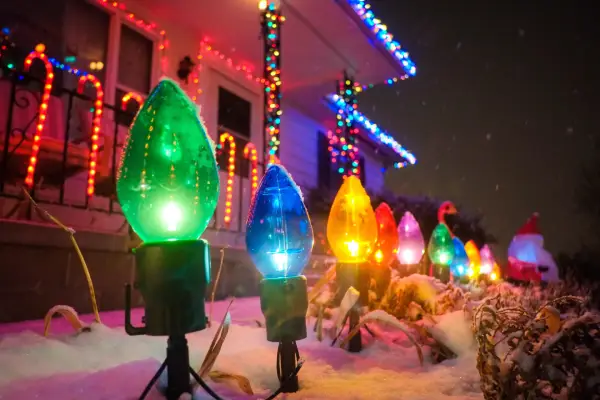
Mr. Electric explains how to estimate the electricity usage of Christmas lights.
|
Who can forget the extravagant holiday lighting display Clark Griswold created in "National Lampoon's Christmas Vacation"? When it comes to Christmas lights, we agree with Clark — more is almost always better. However, covering your home in lights this season is sure to increase your energy bill.
So, just how much electricity do Christmas lights use? Keep reading to find out.

What Factors Affect Holiday Display Energy Usage?
While holiday lighting is beautiful and festive, operating your holiday display can be costly. We’ve listed below some of the key factors that will determine your Christmas display energy costs.
- Home size: The size of your house directly correlates to the amount of energy you use. It takes more light to decorate a large, multi-story home than a smaller, one-story home. To conserve energy and lower costs, consider only hanging lights to accent certain parts of your home.
- Number of lights and display items: The more lights and items powered by electricity you have on and around your home, the higher your energy bill. Cutting back a few strands of lights and limiting display items to one or two will help you save on energy costs.
- What type of Christmas lights do you own? Not all holiday lights use the same amount of energy. For example, a typical strand of 100 incandescent mini light bulbs uses 40 watts of electricity. LED bulbs use far less energy. How much less? For the same cost of running 25 C9 bulbs, you could illuminate 7,200 LED bulbs! That’s a significant saving in energy and dollars.
- How long do you keep your holiday display on? The longer your holiday display is on, the more energy you consume. Want to consume less electricity? Put your lights and display on a timer to limit the number of hours it’s on each night. Also, make sure you turn off your display before you go to bed.

Do Christmas Lights Use a Lot of Electricity?
Although tiny, Christmas bulbs can significantly impact your energy consumption. Households and businesses in the United States use 6.63 billion kilowatt-hours of electricity each year to power holiday displays — that's enough energy to run 14 million refrigerators!
While those figures may seem high, you can do your part to lower energy consumption by switching to energy-efficient lighting options. Upgrading to energy-saving LED Christmas lights is a great start. They put less strain on the environment and your wallet by consuming less energy than older incandescent bulbs.
Here's a comparison of regular incandescent Christmas bulbs vs. energy-saving LED lights:
- Incandescent bulbs are hot to the touch, while LED lights stay cool. Why? Incandescent lights use 90% of the energy they consume to produce heat, not light.
- Incandescent bulbs burn out after about 2,000 hours, but LED bulbs can last as long as 200,000 hours!
- Incandescent bulbs run at a higher wattage than LED bulbs – nearly 90% more! That means they draw more electricity, most of which is turned into heat.
- Incandescent bulbs require multiple outlets to connect several strands. Several LED light strands can be connected to a single outlet.
Because they produce more heat, incandescent bulbs are a greater fire risk, especially when strung on trees, shrubbery, and wooden posts.
What Is the Energy Consumption of Your Holiday Display?
You may wonder how much energy your Christmas light display will consume this season. It's easy to determine the answer using a few simple calculations that we have listed below:
- Know the wattage of your lights. You can find this on the original packaging.
- Determine the kilowatt per hour (KW/h) rate by multiplying the wattage by 0.001. This number tells you how much energy is consumed for each hour of use.
- Figure out how much energy you use each day (KW/d). Simply multiply the KW/h by how many hours you plan to keep the Christmas lights on each day.
- Calculate the kilowatt per season (KW/s) total. Multiply the KW/d by the number of days you plan on running your lights this season (usually 30-35 days).
- Estimate the total cost. Multiply the KW/s by your local power cost (the average is 11.3 cents) to determine your total for the season.
If math isn't your forte, use these ways to reduce your energy consumption. Here are some proactive measures to control energy consumption and the costs associated with your holiday display:
- Switch to LED holiday lights. While they are more expensive to purchase initially, LED lights require less energy, last longer, and are safer than incandescent bulbs.
- Consider fiber optic trees and decorations. Not only do fiber optics look beautiful, they're also energy efficient.
- Install a timer to control how often and how long you run your lights. You can lower costs by simply turning off your lights before heading to bed.
- Turn off other outdoor lights while running your holiday lights. Christmas lights alone are bright enough to illuminate your home’s exterior.
Make Things Merry and Bright with Mr. Electric
Decorating for the holidays doesn't have to make your energy bill skyrocket. Picking the right types of lights and monitoring how often you run them will help you save money this season. If you want the best-lit home in the neighborhood, your local team at Mr. Electric® can help. We can add dedicated circuits and outdoor-safe outlets to accommodate your holiday display. Connect with us online to schedule service with electrical installation and repair services.

